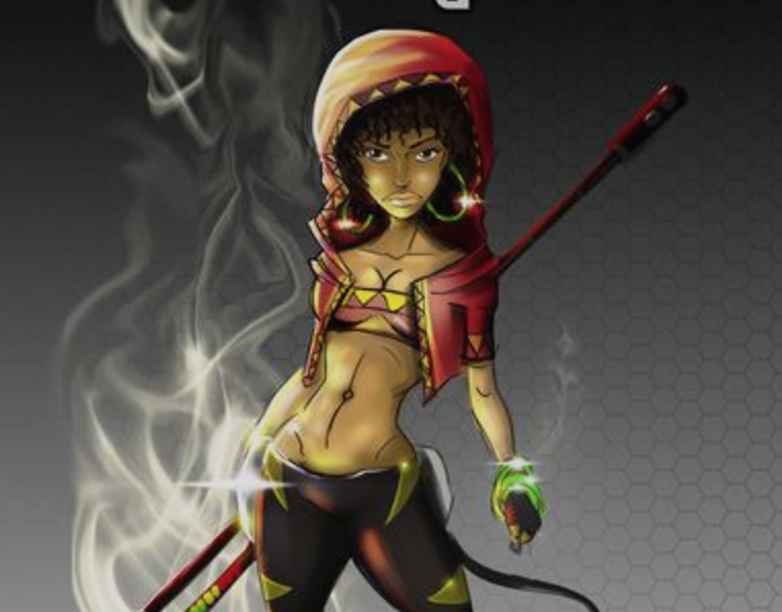Meet Umzingeli. She’s a bounty hunter working with the African Peacekeeping Force. Long lean and deadly with her trusty staff, the Ndebele warrior is locked in a fight for the greater good, against her nemesis, the “sadistic and emotionless” Tesla Morgan.
A fighter with a dark past who uses her skills to fight crime and corruption, Umzingeli is the creation of Eugene Ramirez Mapondera. She joins RazorMan and Sunblast Red in a small but growing legion of Zimbabwean superheroes, pioneering a nascent African comic culture in an industry long dominated by Japanese and American creators.


In a continent with a history of underrepresentation on a global scale, a nascent comics industry is taking hold. At the moment, the large Nigerian studio ComicRepublic is leading the push for more African comics, created by Africans, for an African audience. But smaller, scrappier studios and collectives, like Comexposed in Zimbabwe, are also starting to make a mark.
Zimbabwe is the perfectly positioned for a comic book boom
Zimbabwe is in economic crisis. It is importing too much, and exporting not enough. There’s little cash to go around, and the country may soon reintroduce a new currency. Long queues at banks are once again becoming part of Zimbabwe’s urban landscape.
Faced with these odds, there is a small group of dedicated artists taking matters into their own hands.
“It’s actually when things are difficult that people need ideals and heroes to believe in, and comic books can provide that”, explains Tafadzwa Banda, a comic book writer based in Harare. “America’s comic book industry was built during the Great Depression. So no one should see Zimbabwe’s depression as a hindrance. It’s an opportunity.”
Comexposed was assembled in 2013. A collective of artists, designers and animators, Comexposed is driving the movement in Zimbabwe for local comics. As its co-founder, Mapondera explains the movement’s vision: “Comexposed has made its mandate the creation or establishment of the local comic book industry. The events we hold are attempting to supplement the absence of market places for comic books and related merchandise.”
These artists have created grand superheroes and have even grander dreams, but the question of finances lingers even as they speak about their ventures, excitedly describing their characters and their origin stories. Are comics able to make money in Africa? Is it wise to start such an Asian and American dominated sphere when economic conditions look less than favorable?
Times of difficulty push them to dream and imagine what their country could be, a sentiment shared by many of their countrymen. Although issues such as corruption and crime provide fodder for their stories, the comics they create provide an escape from what is often a depressing reality.
Although gaining momentum, comics in Zimbabwe are nothing new. Educational comics such as the Sara Communication Initiative were used to address societal issues such as HIV/AIDS, education for girls, and the position of women in society. They were also used during the liberation war, with writers and artists hiding behind pen names while publishing content filled with political rhetoric. However, this genre of comics didn’t quite take off. “The problem with previous comic creators wise that they weren’t serious about their craft. They expected to make half-baked work and to be turning profit after two months,” says Banda.


What distinguishes this resurgence is its influence from Western and Eastern culture.
Bill Masuku, co-founder of AfriNerd and an artist, watches a lot of anime and it’s translated into his work. “It [anime] affected my writing as I have consumed a significant amount of Japanese content.” As much as manga and comics have influenced style and format, they retain their Zimbabwean identity in the work they produce. Masuku says he couldn’t start production on his character RazorMan while he was away from Zimbabwe. “My environment affects my writing and drawing. Home is where the art is.”
There have been successes in Africa’s young comics industry. South Africa’s Supa Strikas comes to mind. Published in several languages and in different countries, the story of a Pan African soccer team now has its own cartoon on Disney and a local network Etv. Zimbabwe’s industry is still small, but its players are planning big. “As comics creators we are all for global domination. We want a creative economy and industry in Zimbabwe and in Africa. People should be able to live off what they love to do, and empower the wider community because of it,” says Tinodiwa Makoni, who’s started his own creative studio and works as an animator and illustrator.
For the small but dedicated group of artists, the comics they read and the cartoons they watched form a big part of their lives and how they see the world. The humble comic introduced them to new cultures, modes of thinking, new realities and possibilities, and for young minds, it opened up the world. It is this magic and fantasy that they want to contribute to Africa’s already vibrant cultural landscape. With each new superhero and story arc, Africa’s comic book artists continue a decades-long tradition, while creating their own representations and realities.
